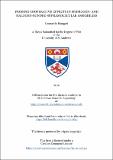Files in this item
Probing cooperative effects in hydrogen- and halogen-bonded supramolecular assemblies
Item metadata
| dc.contributor.advisor | Philp, Douglas | |
| dc.contributor.author | Maugeri, Leonardo | |
| dc.coverage.spatial | xiv, 249 p. | en_US |
| dc.date.accessioned | 2017-05-25T10:12:56Z | |
| dc.date.available | 2017-05-25T10:12:56Z | |
| dc.date.issued | 2016-11-30 | |
| dc.identifier.uri | https://hdl.handle.net/10023/10853 | |
| dc.description.abstract | This Thesis describes the fundamental features and applications of the supramolecular assemblies generated by molecular systems incorporating two different sets of self-complementary molecular recognition units based on either hydrogen or halogen bonds. In Chapter 1, an overview of the noncovalent interactions exploited in supramolecular chemistry to date is provided through illustrative examples. The concept of cooperativity is introduced and analysed: with particular emphasis on the concept of chelate cooperativity. The different definitions and analyses of this phenomenon, as described by different authors, are discussed. Chapter 2 provides an introduction to synthetic self-replicating systems. Starting from the description of the minimal model of self-replication and its kinetic analyses, a brief review of the relevant literature is proposed from the first synthetic deoxyribonucleotide-based self-replicating system to small molecule replicators. The self-replicating abilities of isoxazolidine-based replicators are described in depth through examples showing their efficiency in isolation and within different scenarios in which they are in competition with each other. Chapter 3 describes the design, synthesis and applications of a new isoxazolidine-based self-replicator that benefits from recognition elements that have significantly increased association constants. The efficiency of this self-replicator is tested in isolation and in a simple competition scenario in presence of a competitor isoxazolidine-based replicator. The limitations of this system are identified and analysed and, in order to overcome these, a modified system is synthesised and its performance is compared with other replicators. In Chapter 4, the concept of halogen bonding is introduced through its early historical developments up to its recent definition and rationalisation. The solid state and solution state applications of this noncovalent interaction in the current literature are reviewed. The designs and syntheses of two molecular scaffolds incorporating a variously substituted iodophenyl-based halogen bond donors and a pyridine-based halogen bond acceptors are discussed and analysed by means of DFT calculations and their solid state structures. The limitations of these early designs are evaluated. Chapter 5 reports the design and syntheses of a novel class of halogen bond donors, namely 5-iodo-1-(perfluorophenyl)-4-phenyl-1,2,3-triazoles. The halogen bond properties of this Lewis acidic species are examined computationally as well as in the solid and solution states. The ability of these halogen bond donors to be easily combined with nitrogen- and oxygen-based halogen bond acceptors leading to self-complementary molecules able to dimerise in solution through the formation of halogen bonds is described. Chapter 6 describes the implementation of strong oxygen-based halogen bond acceptors to iodotriazole-based halogen bond donors. The ability of these systems to associate in solution and in thin films to form stable and functional halogen bonded assemblies is demonstrated. Chapter 7 provides a summary of the research presented within this Thesis and highlights some possible future directions. Experimental details of the synthetic procedures described in this thesis are given in Chapter 8. Chapter 9 lists the references cited within this Thesis. | en |
| dc.language.iso | en | en_US |
| dc.publisher | University of St Andrews | |
| dc.rights | Attribution-NonCommercial-NoDerivatives 4.0 International | * |
| dc.rights.uri | http://creativecommons.org/licenses/by-nc-nd/4.0/ | * |
| dc.subject | Self-replicating systems | en |
| dc.subject | Halogen bonding | en |
| dc.subject | Cooperativity | en |
| dc.subject | Chelate cooperativity | en |
| dc.subject.lcc | QD878.M2 | |
| dc.subject.lcsh | Supramolecular chemistry | en |
| dc.subject.lcsh | Chemical bonds | en |
| dc.title | Probing cooperative effects in hydrogen- and halogen-bonded supramolecular assemblies | en_US |
| dc.type | Thesis | en_US |
| dc.type.qualificationlevel | Doctoral | en_US |
| dc.type.qualificationname | PhD Doctor of Philosophy | en_US |
| dc.publisher.institution | The University of St Andrews | en_US |
The following licence files are associated with this item:
This item appears in the following Collection(s)
Except where otherwise noted within the work, this item's licence for re-use is described as Attribution-NonCommercial-NoDerivatives 4.0 International
Items in the St Andrews Research Repository are protected by copyright, with all rights reserved, unless otherwise indicated.


